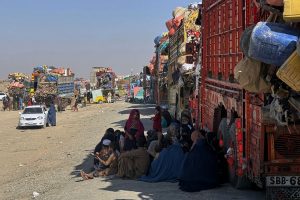KABUL, Afghanistan (AP) — The return of millions of Afghan nationals to their home country is placing extreme pressure on already struggling communities, with nine in 10 families in areas with high rates of return now either going hungry, sliding into debt or selling their belongings to survive, according to the United Nations.
A survey released Wednesday by the United Nations Development Program said the return of 2.3 million Afghans so far this year, many of them forced out of neighboring Iran and Pakistan, had “sharply intensified pressure on already fragile systems.”
Afghanistan was already struggling after decades of conflict, recent earthquakes, climate shocks and economic contraction, the UNDP report said, noting that the arrival of millions of returning Afghans “has increased competition for jobs, water and housing, further straining social cohesion and local services.”
The report was based on an assessment of 48,711 Afghan households, including just over 1,500 returnee families, carried out in July and August in all 34 provinces of Afghanistan. Ninety percent of households in areas where there have been a high level of returns reported having to resort to skipping meals, selling belongings or borrowing, the report said.
Women and girls have been particularly badly affected, the UNDP said. Afghanistan’s Taliban-led government has severely curtailed the rights of women and girls, including placing restrictions on their movements outside the home and banning them from most jobs, as well as from secondary and university education.
“Afghanistan’s returnee and host communities are under immense strain,” said Kanni Wignaraja, UN Assistant Secretary-General and the UNDP’s regional director for Asia and the Pacific. “In some provinces one in four households depend on women as the main breadwinner, so when women are prevented from working, families, communities, the country lose out.”
More than 4.5 million people have returned to Afghanistan since September 2023, increasing the country’s population by 10%, the report said. “Mass returns have occurred against a backdrop of sharp economic decline stretching back to 2021, weak capacity in social and economic institutions following the years of conflict, shrinking aid, and recurrent climate shocks.”
More than half of families who have returned reported foregoing medical care in order to afford food, while access to clean water is increasingly under strain, with local communities and returning Afghans relying on seasonal rivers, shallow wells or springs, the report said.
Earthquakes, flash floods and a severe drought have also battered the country. A major quake and aftershocks that hit eastern Afghanistan in August killed more than 2,200 people. Some of the regions affected were those with some of the highest levels of returnees, with the UNDP saying 1 million people were affected by the quakes, and more than 8,300 homes were destroyed. Another powerful quake struck northern Afghanistan earlier this month, killing 27 and injuring nearly 1,000 more.
“Taken together, the overlapping stresses of chronic poverty, large-scale returns, climate and seismic shocks, declining aid, and gender-based exclusion have created a perfect storm. Fragile host districts bear the burden of displacement, eroding social cohesion and putting community resilience under pressure,” the report said.
The UNDP said that “sustained diplomatic engagement” by UN member states could help protect vulnerable populations.
“Urgent action is needed now, before the challenges in the areas of return entrench displacement, exclusion, and instability, and fuel fresh waves of displacement and outward migration,” the UNDP report said, adding that “Afghanistan cannot afford delay, nor can the region.”
___
Becatoros reported from Athens, Greece
By ABDUL QAHAR AFGHAN and ELENA BECATOROS

